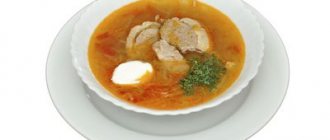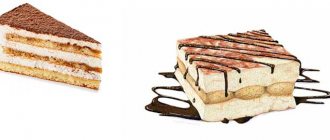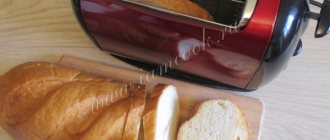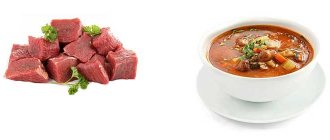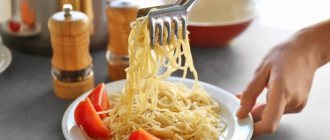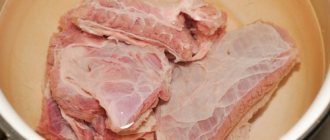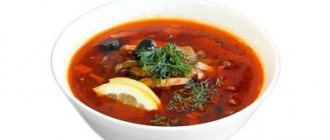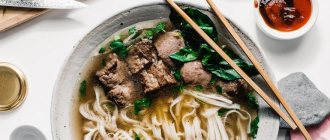Features of cooking in a multicooker
If you have a multicooker in your kitchen, then feel free to start cooking lean borscht in it. Having tried to cook the first one in this way, you will certainly appreciate all its advantages. The borscht turns out to be very rich and rich, because the ingredients are not cooked quickly, but simmer slowly and release all their flavors.
To prepare, you need to separately fry it with tomatoes and beets, put it in a multicooker bowl, then add the rest of the ingredients, add water and put it in the “Stew” mode for 1 hour 30 minutes. After turning off, keep it in the “Warming” mode for another 20 minutes to allow the borscht to infuse.
If you have a pressure cooker, then you need to cook according to the “Soup” program for 30 minutes, and then also use the heating function.
This recipe is considered a classic; it produces an incomparable borscht that makes you want to ask for more. But how many different versions of this dish can be obtained by adding fresh green peas, sorrel, canned beans, red salad peppers, celery, prunes, mushrooms and even sprat to it! Each of these ingredients will add a special piquancy to your dish and will diversify the traditional sour taste of lean borscht. Don't be afraid to experiment in the kitchen!
Did you like the recipe? Save it to yourself on Pinterest, FB, VK, OK, G+, Instagram so as not to lose it!
Lenten borscht recipe. Calorie, chemical composition and nutritional value.
Nutritional value and chemical composition of “lenten borscht”.
The table shows the nutritional content (calories, proteins, fats, carbohydrates, vitamins and minerals) per 100 grams of edible portion.
| Nutrient | Quantity | Norm** | % of the norm in 100 g | % of the norm in 100 kcal | 100% normal |
| Calorie content | 32.1 kcal | 1684 kcal | 1.9% | 5.9% | 5246 g |
| Squirrels | 0.6 g | 76 g | 0.8% | 2.5% | 12667 g |
| Fats | 2 g | 56 g | 3.6% | 11.2% | 2800 g |
| Carbohydrates | 2.9 g | 219 g | 1.3% | 4% | 7552 g |
| Organic acids | 0.1 g | ~ | |||
| Alimentary fiber | 0.7 g | 20 g | 3.5% | 10.9% | 2857 g |
| Water | 92.5 g | 2273 g | 4.1% | 12.8% | 2457 g |
| Ash | 0.769 g | ~ | |||
| Vitamins | |||||
| Vitamin A, RE | 104.1 mcg | 900 mcg | 11.6% | 36.1% | 865 g |
| beta carotene | 0.629 mg | 5 mg | 12.6% | 39.3% | 795 g |
| Vitamin B1, thiamine | 0.02 mg | 1.5 mg | 1.3% | 4% | 7500 g |
| Vitamin B2, riboflavin | 0.02 mg | 1.8 mg | 1.1% | 3.4% | 9000 g |
| Vitamin B4, choline | 0.95 mg | 500 mg | 0.2% | 0.6% | 52632 g |
| Vitamin B5, pantothenic | 0.059 mg | 5 mg | 1.2% | 3.7% | 8475 g |
| Vitamin B6, pyridoxine | 0.07 mg | 2 mg | 3.5% | 10.9% | 2857 g |
| Vitamin B9, folates | 6.46 mcg | 400 mcg | 1.6% | 5% | 6192 g |
| Vitamin C, ascorbic acid | 4.3 mg | 90 mg | 4.8% | 15% | 2093 g |
| Vitamin E, alpha tocopherol, TE | 0.95 mg | 15 mg | 6.3% | 19.6% | 1579 g |
| Vitamin H, biotin | 0.199 mcg | 50 mcg | 0.4% | 1.2% | 25126 g |
| Vitamin K, phylloquinone | 7.3 mcg | 120 mcg | 6.1% | 19% | 1644 g |
| Vitamin RR, NE | 0.366 mg | 20 mg | 1.8% | 5.6% | 5464 g |
| Niacin | 0.226 mg | ~ | |||
| Macronutrients | |||||
| Potassium, K | 119.7 mg | 2500 mg | 4.8% | 15% | 2089 g |
| Calcium, Ca | 18.71 mg | 1000 mg | 1.9% | 5.9% | 5345 g |
| Magnesium, Mg | 7.86 mg | 400 mg | 2% | 6.2% | 5089 g |
| Sodium, Na | 197.21 mg | 1300 mg | 15.2% | 47.4% | 659 g |
| Sera, S | 7.45 mg | 1000 mg | 0.7% | 2.2% | 13423 g |
| Phosphorus, P | 16.2 mg | 800 mg | 2% | 6.2% | 4938 g |
| Chlorine, Cl | 297.59 mg | 2300 mg | 12.9% | 40.2% | 773 g |
| Microelements | |||||
| Aluminium, Al | 119.9 mcg | ~ | |||
| Bor, B | 44.5 mcg | ~ | |||
| Vanadium, V | 14.59 mcg | ~ | |||
| Iron, Fe | 0.347 mg | 18 mg | 1.9% | 5.9% | 5187 g |
| Yod, I | 1.2 mcg | 150 mcg | 0.8% | 2.5% | 12500 g |
| Cobalt, Co | 1.16 mcg | 10 mcg | 11.6% | 36.1% | 862 g |
| Lithium, Li | 5.3 mcg | ~ | |||
| Manganese, Mn | 0.0755 mg | 2 mg | 3.8% | 11.8% | 2649 g |
| Copper, Cu | 45.18 mcg | 1000 mcg | 4.5% | 14% | 2213 g |
| Molybdenum, Mo | 3.05 mcg | 70 mcg | 4.4% | 13.7% | 2295 g |
| Nickel, Ni | 2.617 mcg | ~ | |||
| Rubidium, Rb | 63.9 mcg | ~ | |||
| Selenium, Se | 0.05 mcg | 55 mcg | 0.1% | 0.3% | 110000 g |
| Fluorine, F | 22.66 mcg | 4000 mcg | 0.6% | 1.9% | 17652 g |
| Chromium, Cr | 2.47 mcg | 50 mcg | 4.9% | 15.3% | 2024 |
| Zinc, Zn | 0.1143 mg | 12 mg | 1% | 3.1% | 10499 g |
| Digestible carbohydrates | |||||
| Starch and dextrins | 0.994 g | ~ | |||
| Mono- and disaccharides (sugars) | 2 g | max 100 g | |||
| Glucose (dextrose) | 0.39 g | ~ | |||
| Sucrose | 0.805 g | ~ | |||
| Fructose | 0.195 g | ~ | |||
| Essential amino acids | 0.12 g | ~ | |||
| Arginine* | 0.021 g | ~ | |||
| Valin | 0.019 g | ~ | |||
| Histidine* | 0.006 g | ~ | |||
| Isoleucine | 0.016 g | ~ | |||
| Leucine | 0.02 g | ~ | |||
| Lysine | 0.022 g | ~ | |||
| Methionine | 0.005 g | ~ | |||
| Methionine + Cysteine | 0.01 g | ~ | |||
| Threonine | 0.015 g | ~ | |||
| Tryptophan | 0.004 g | ~ | |||
| Phenylalanine | 0.016 g | ~ | |||
| Phenylalanine+Tyrosine | 0.031 g | ~ | |||
| Nonessential amino acids | 0.242 g | ~ | |||
| Alanin | 0.017 g | ~ | |||
| Aspartic acid | 0.06 g | ~ | |||
| Glycine | 0.015 g | ~ | |||
| Glutamic acid | 0.07 g | ~ | |||
| Proline | 0.016 g | ~ | |||
| Serin | 0.019 g | ~ | |||
| Tyrosine | 0.014 g | ~ | |||
| Cysteine | 0.005 g | ~ | |||
| Sterols (sterols) | |||||
| beta sitosterol | 3.987 mg | ~ | |||
| Saturated fatty acids | |||||
| Saturated fatty acids | 0.2 g | max 18.7 g | |||
| 16:0 Palmitinaya | 0.123 g | ~ | |||
| 18:0 Stearic | 0.079 g | ~ | |||
| 20:0 Arakhinovaya | 0.006 g | ~ | |||
| 22:0 Begenovaya | 0.013 g | ~ | |||
| Monounsaturated fatty acids | 0.464 g | min 16.8 g | 2.8% | 8.7% | |
| 18:1 Oleic (omega-9) | 0.462 g | ~ | |||
| Polyunsaturated fatty acids | 1.144 g | from 11.2 to 20.6 g | 10.2% | 31.8% | |
| 18:2 Linolevaya | 1.144 g | ~ | |||
| 18:3 Linolenic | 0.005 g | ~ |
The energy value of lean borscht is 32.1 kcal.
Primary Source: Created in the application by the user. Read more.
** This table shows the average levels of vitamins and minerals for an adult. If you want to know the norms taking into account your gender, age and other factors, then use the “My Healthy Diet” application.
Calorie content of borscht
100 grams of Ukrainian borscht can contain different amounts of calories. It all depends on the set of ingredients for the red soup. For this reason, the calorie content of borscht with chicken will differ significantly from its vegetarian counterpart cooked in water.
On a note! The calorie content of a plate of borscht is easy to determine - it holds 250 grams of red soup.
Without meat
Photo source: shutterstock.com
Vegetarians often choose borscht in water without meat as a first course. 100 grams of this light soup contains:
- proteins – 0.6 g;
- fat – 1.3 g;
- carbohydrates – 3.8 g.
At the same time, the calorie content of borscht without meat is only 28 kcal. Such a tiny number of calories cannot have a negative impact on your figure.
On a note! Lenten borscht is a tasty and healthy dietary dish.
With pork
Photo source: shutterstock.com
If you prepare borscht from pork, the calorie content per 100 grams will be 68 kcal. The level of fat and carbohydrates will be almost the same - 3.5 g, and protein will be slightly higher - 5.5 g.
Many people prefer to cook soup with pork ribs. This is allowed, but this option is not suitable for those losing weight due to the high calorie content. If you replace sauerkraut with fresh cabbage, the calorie content of borscht with pork will also increase.
On a note! The nutritional value of pork borscht will be higher if it includes frying.
With beef
Photo source: shutterstock.com
The calorie content of borscht with beef is only 30.6 kcal. If you cook a dish with beef broth, its energy value per 100 g will be:
- proteins – 1.7 g;
- fats – 1.7 g;
- carbohydrates – 2.2 g.
In one serving of this soup their quantity will increase by 2.5 times. It is not difficult to calculate this, since the plate holds 205 g of borscht.
With Chiken
Photo source: shutterstock.com
Many housewives love borscht with chicken breast or turkey. Preparing such a tasty, healthy and low-calorie dish is recommended for those losing weight.
It’s not difficult to figure out how many calories are in a plate of borscht with chicken. For every 100 g of stew there are only 28 kcal. But the BJU looks like this:
- proteins – 4.1 g;
- fats – 1.6 g;
- carbohydrates – 3.9 g.
With sour cream
Photo source: shutterstock.com
Whatever version of borscht you choose - with pork, with chicken, with fresh cabbage or on a lean basis, it is served with sour cream. It not only improves the taste of the soup, but also makes it more nutritious. However, those losing weight will have to take into account that eating borscht with sour cream will approximately double the calorie content of the dish. So, if borscht with beef contains no more than 30 kcal, then with sour cream its calorie content will reach 60 kcal.
What determines the calorie content of borscht with beef?
Butter is one of the fattest components of the recipe (100 g/899 kcal).
When frying, foods absorb 20-50% of the oil used.
During cooking, part of the fat contained in the meat goes into the broth (10-20%), and part of the sugars from vegetables. You can remove excess saturated fat by draining the first broth.
How many calories are in a serving of borscht?
Borscht made with beef broth is considered traditional, so using its example we will now look at the calorie content. To do this, it is necessary to take into account the nutritional value of all components of the product. The broth can be made from pulp or meat on the bone. To reduce calorie content and improve the quality of the finished borscht, after the meat boils and foam appears, you need to change the water. This will make the broth not only cleaner, but also less caloric.
Let's calculate the calorie content and energy value of 100 grams of the finished product, if 1 kg of meat is placed in 4 liters of water.
- If the meat was with a bone during cooking, then the broth contains approximately 25 kcal.
- If it was prepared from pulp, then the calorie content of the broth is approximately 30 kcal.
Nutritional value also differs between bone and meat broth.
- Meat contains 2.3 g of protein, 1.1 g of fat, 2.6 g of carbohydrates.
- Bone contains 4 g of proteins, 1.3 g of fat, 0.2 g of carbohydrates.
A standard set of vegetables is often used to prepare the dish. Many housewives add beets, cabbage, potatoes, onions, carrots, seasonings, and herbs during cooking. For frying, use vegetable oil or lard, as well as tomato juice or paste. When serving, add sour cream or mayonnaise to a serving plate. With this addition, the serving becomes 50-60 kcal more caloric.
Here is the calorie content of the vegetables that are part of the dish:
- Cabbage – 24 kcal.
- Potatoes – 76 kcal.
- Beets – 51 kcal.
- Onions – 40 kcal.
- Carrots – 38 kcal.
Considering all this data, we can conclude that the calorie content of borscht with beef is approximately 40-60 calories per 100 grams. One serving will give you 200 kcal, and with the addition of mayonnaise or sour cream - approximately 250 kcal. The calorie content of borscht with chicken will also depend on many nuances, the quality of the meat, the amount of ingredients, but on average there are 40-60 kcal per 100 grams of product
Much depends on the amount of meat and water for the broth. For example, if you take 1 kg of pork for borscht and 4 liters of water, the calorie content of the finished product will be approximately 60 kcal; if you reduce the amount of pork, the calorie content will drop to 35-40 kcal.
Recipes for a caring housewife
Pork
| Water | 3 l |
| Pork | 500 g |
| Potato | 500 g |
| Cabbage | 600 g |
| Carrot | 1 PC. |
| Onion | 2 pcs. |
| Bay leaf | 2 pcs. |
| Tomato paste | 2 tbsp. l. |
| Vegetable oil | 2 tbsp. l. |
| Salt | 1-2 tsp. |
| Boiled beets | 200 g |
| Garlic | 2 cloves |
First, boil the meat broth. Then you need to peel, wash, and chop all the vegetables. Add chopped potatoes to the broth and let simmer for 10 minutes. Then add the shredded cabbage to the pan. Then fry the vegetables in a slow cooker or frying pan. Pour in vegetable oil, let it heat up, then add onions and carrots to it.
Sauté for a minute or two, add beets and tomato paste. Add the roast to the rest of the ingredients, add bay leaf and salt, let the dish simmer for a couple of minutes, then add chopped garlic, remove from heat, cover and let stand for 10-15 minutes. You can also add any spices, such as pepper, to your taste. When serving, add herbs and sour cream.
- Calorie content 36.7 kcal per 100 grams of product.
- Amount of proteins – 1.7 g, fats – 1.9 g, carbohydrates – 3.7 g.
Lean
| Cabbage | 300 g |
| Onion | 2 pcs. |
| Carrot | 1 PC. |
| Beet | 100 g |
| Parsley | 1 bunch |
| Dill | 1 bunch |
| Vegetable oil | 2 tbsp. l. |
| Water | 2 l |
| Salt | 1 tsp. |
| Vinegar | 1 tbsp. l. |
| Tomato paste | 1 tbsp. l. |
Let the water boil, add grated beets and vinegar to preserve the rich color of the vegetable. Fry onions and carrots in vegetable oil, add tomato paste to them. Add shredded cabbage, fried vegetables, and salt to the beets. Cooking time 20 minutes. Add garlic and herbs to the finished dish and garnish with parsley when serving.
- 100 grams of the finished dish contains 20 kcal, proteins - 0.5 g, fats - 1.1 g, carbohydrates - 2.3 g.
Traditional
| Water | 3 l |
| Meat on the bone (pork or beef) | 1 kg |
| Potato | 600 g |
| Cabbage | 500 g |
| Carrot | 1 PC. |
| Onion | 2 pcs. |
| Beet | 100 g |
| Salt | 1-2 tsp. |
| Vegetable oil | 2 tbsp. l. |
| Tomato paste | 2 tbsp. l. |
| Ground pepper | 2 pinches |
| Greenery | 1 bunch |
| Vinegar | 1 tbsp. l. |
| Lemon | 1 tbsp. l. |
| Sugar | 20 g |
Pour water over the meat and cook for 1 hour. After this, strain the broth, remove the meat, cut it into portions. Grind the beets, sprinkle with lemon juice, stir, and sauté over low heat. Add vinegar, sugar to it, mix well, add tomato paste, a glass of broth. Simmer until fully cooked. Separately, fry the onions and carrots.
Add potatoes to the broth, after 10 minutes of cooking, add pre-shredded cabbage and fried onions and carrots. After 5 minutes of boiling, add beets and chopped meat. You can remove from heat after 10 minutes, adding salt and spices as desired.
- 100 grams of this dish contains 63 kcal , fat - 3.6 g, protein - 4.4 g, carbohydrates - 5.5 g.

